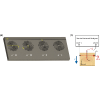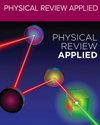具有局部欺骗性表面等离子体极化子的混合磁性元件
IF 4.4
2区 物理与天体物理
Q2 PHYSICS, APPLIED
引用次数: 0
摘要
混合磁子系统已成为保留相干性的信息传播的一个有前途的方向。由于磁子具有很高的可调谐性,因此可以通过设计磁子与微波光子的相互作用来探测基于强光子-磁子耦合的新现象。可以通过调整微波谐振器的结构来提高光子-磁子耦合强度,从而更好地与对应的磁子相互作用。由于平面谐振器具有片上集成的潜力,人们对其进行了探索,但只使用了基于条纹谐振器的共模。在这里,我们提出了一种支持欺骗性局部表面等离子体(LSP)的微波螺旋谐振器,并将其用于混合磁子应用的光子-磁子耦合研究。我们利用铁磁性钇铁石榴石球展示了强大的磁子-LSP 光子耦合。我们通过实验和模拟讨论了螺旋谐振器的光子模式频率和空间场分布的工程能力。由于光子模式剖面的局部化,所产生的磁场集中在表面电介质附近,从而提高了磁填充因子。强耦合和大工程空间使欺骗性 LSP 成为开发新型混合磁性系统和功能的有趣竞争者。本文章由计算机程序翻译,如有差异,请以英文原文为准。

Hybrid magnonics with localized spoof surface-plasmon polaritons
Hybrid magnonic systems have emerged as a promising direction for information propagation with preserved coherence. Because of the high tunability of magnons, their interactions with microwave photons can be engineered to probe novel phenomena based on strong photon-magnon coupling. Improving the photon-magnon coupling strength can be done by tuning the structure of microwave resonators to better interact with the magnon counterpart. Planar resonators have been explored due to their potential for on-chip integration, but only common modes from stripline-based resonators have been used. Here, we present a microwave spiral resonator supporting spoof localized surface plasmons (LSPs) and implement it in the investigation of photon-magnon coupling for hybrid magnonic applications. We showcase strong magnon-LSP photon coupling using a ferrimagnetic yttrium iron garnet sphere. We discuss the engineering capacity of the photon mode frequency and spatial field distributions of the spiral resonator via both experiment and simulation. As a result of the localized photon mode profiles, the resulting magnetic field concentrates near the surface dielectrics, giving rise to an enhanced magnetic filling factor. The strong coupling and large engineering space render the spoof LSPs an interesting contender in developing novel hybrid magnonic systems and functionalities.
求助全文
通过发布文献求助,成功后即可免费获取论文全文。
去求助
来源期刊

Physical Review Applied
PHYSICS, APPLIED-
CiteScore
7.80
自引率
8.70%
发文量
760
审稿时长
2.5 months
期刊介绍:
Physical Review Applied (PRApplied) publishes high-quality papers that bridge the gap between engineering and physics, and between current and future technologies. PRApplied welcomes papers from both the engineering and physics communities, in academia and industry.
PRApplied focuses on topics including:
Biophysics, bioelectronics, and biomedical engineering,
Device physics,
Electronics,
Technology to harvest, store, and transmit energy, focusing on renewable energy technologies,
Geophysics and space science,
Industrial physics,
Magnetism and spintronics,
Metamaterials,
Microfluidics,
Nonlinear dynamics and pattern formation in natural or manufactured systems,
Nanoscience and nanotechnology,
Optics, optoelectronics, photonics, and photonic devices,
Quantum information processing, both algorithms and hardware,
Soft matter physics, including granular and complex fluids and active matter.
 求助内容:
求助内容: 应助结果提醒方式:
应助结果提醒方式:


